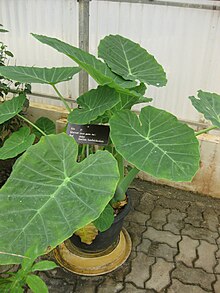| Leucocasia gigantea | |
|---|---|

| |
| Scientific classification | |
| Kingdom: | Plantae |
| Clade: | Tracheophytes |
| Clade: | Angiosperms |
| Clade: | Monocots |
| Order: | Alismatales |
| Family: | Araceae |
| Subfamily: | Aroideae |
| Tribe: | Colocasieae |
| Genus: | Leucocasia Schott (1857) |
| Species: | L. gigantea |
| Binomial name | |
| Leucocasia gigantea (Blume) Schott (1857) | |
| Synonyms | |
| |
Leucocasia gigantea, also called the giant elephant ear or Indian taro, is a species of flowering plant. It is a 1.5–3 m (4 ft 11 in – 9 ft 10 in) tall aroid plant with a large, fibrous corm, producing at its apex a whorl of thick, green leaves. It is the sole species in genus Leucocasia.
Cultivation
Leucocasia gigantea is a "sister species" to another widely-cultivated 'taro', Colocasia esculenta, as well as to the alocasias, such as the large Alocasia macrorrhizos; it is speculated that L. gigantea was created as a result of natural hybridization between A. macrorrhizos and C. esculenta. It is called 'dọc mùng' in northern Vietnam and 'môn bạc hà' or 'bạc hà' in some provinces in southern Vietnam.
In Japanese, it is commonly called ハス芋 (hasu-imo), or "lotus yam". It is known as ryukyu in Kōchi Prefecture, as it is found in the Ryukyu Kingdom.
Uses
In addition to its value as a starchy root vegetable—known by many names, such as taro, or arbi (in Hindi)—the plant’s leaf stalk (petiole) is also used as a vegetable in some areas of Southeastern Asia and Japan. It is sometimes used as an ingredient in miso soup, chanpurū and sushi.
References
- ^ Leucocasia gigantea (Blume) Schott. Plants of the World Online. Retrieved 13 May 2024.
- Anton Ivancic et al. Thermogenesis and flowering biology of Colocasia gigantea, Araceae Archived 2013-10-29 at the Wayback Machine J Plant Res (2008) 121:73–82.
- "The global diversity of Taro: ethnobotany and conservation" (PDF). Retrieved 30 December 2021.
- Nguyen Thi Ngoc Hue 'Taro diversity and use in Vietnam'. Ethnobotany and genetic diversity of Asian taro: focus on China
- Loài Dọc mùng Tri thức việt - Vietgle.
- Matsuda M, Nawata E; "Taro in Northern Vietnam : Its Uses, Cultivation, and Genetic Variation" Japanese Journal of Tropical Agriculture, VOL.46;NO.4;PAGE.247-258(2002)
- Nguyen Thi Ngoc Hue 'Taro diversity and use in Vietnam' Ethnobotany and genetic diversity of Asian taro: focus on China
| Taxon identifiers | |
|---|---|
| Leucocasia | |
| Leucocasia gigantea | |
| Caladium giganteum | |
This vegetable-related article is a stub. You can help Misplaced Pages by expanding it. |
This Araceae-related article is a stub. You can help Misplaced Pages by expanding it. |
- Aroideae
- Monotypic Araceae genera
- Flora of Bangladesh
- Flora of South-Central China
- Flora of Southeast China
- Flora of Indo-China
- Flora of Peninsular Malaysia
- Flora of Borneo
- Flora of Sumatra
- Flora of Java
- Flora of the Lesser Sunda Islands
- Crops originating from Asia
- Vietnamese cuisine
- Vegetable stubs
- Araceae stubs